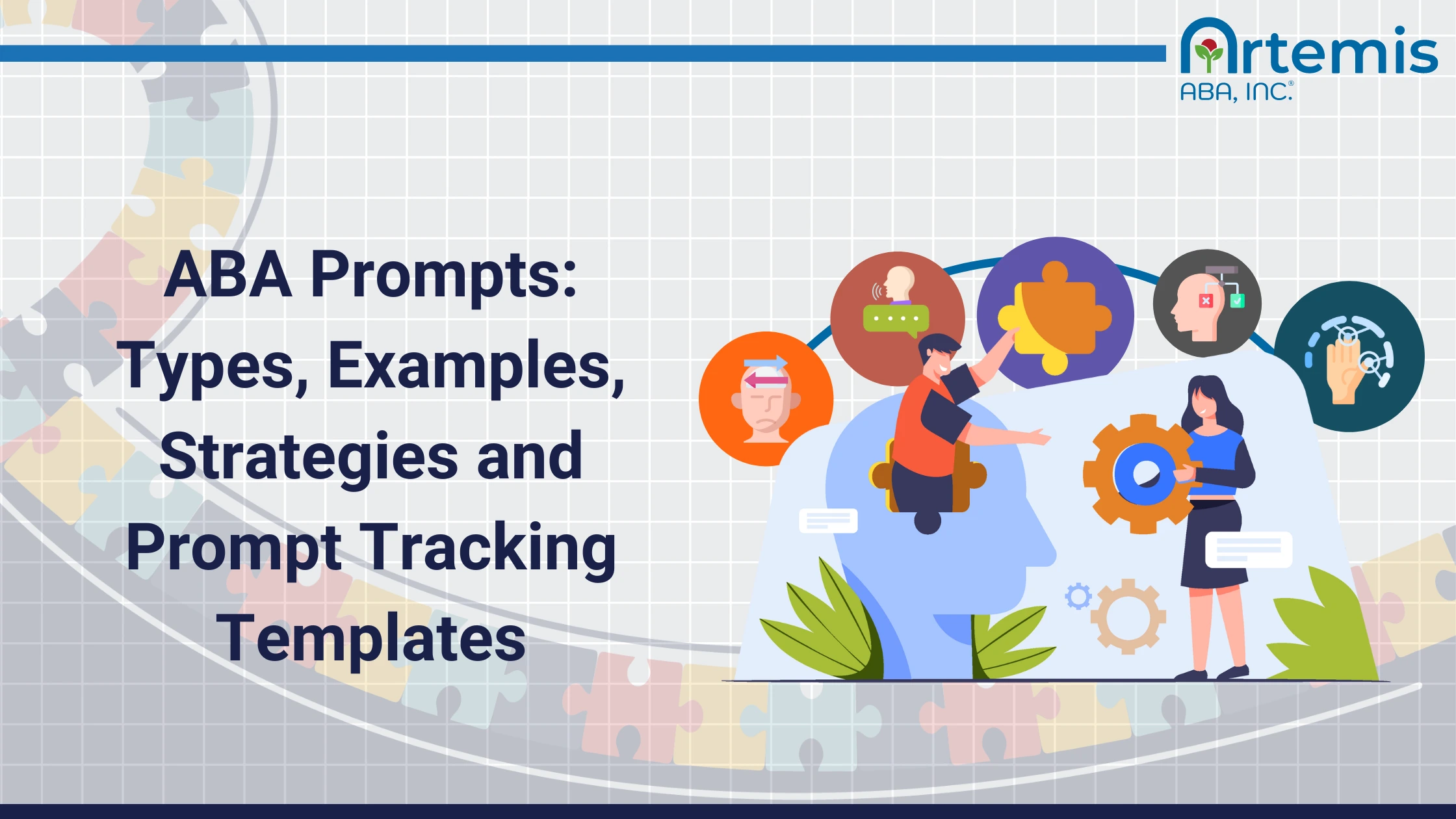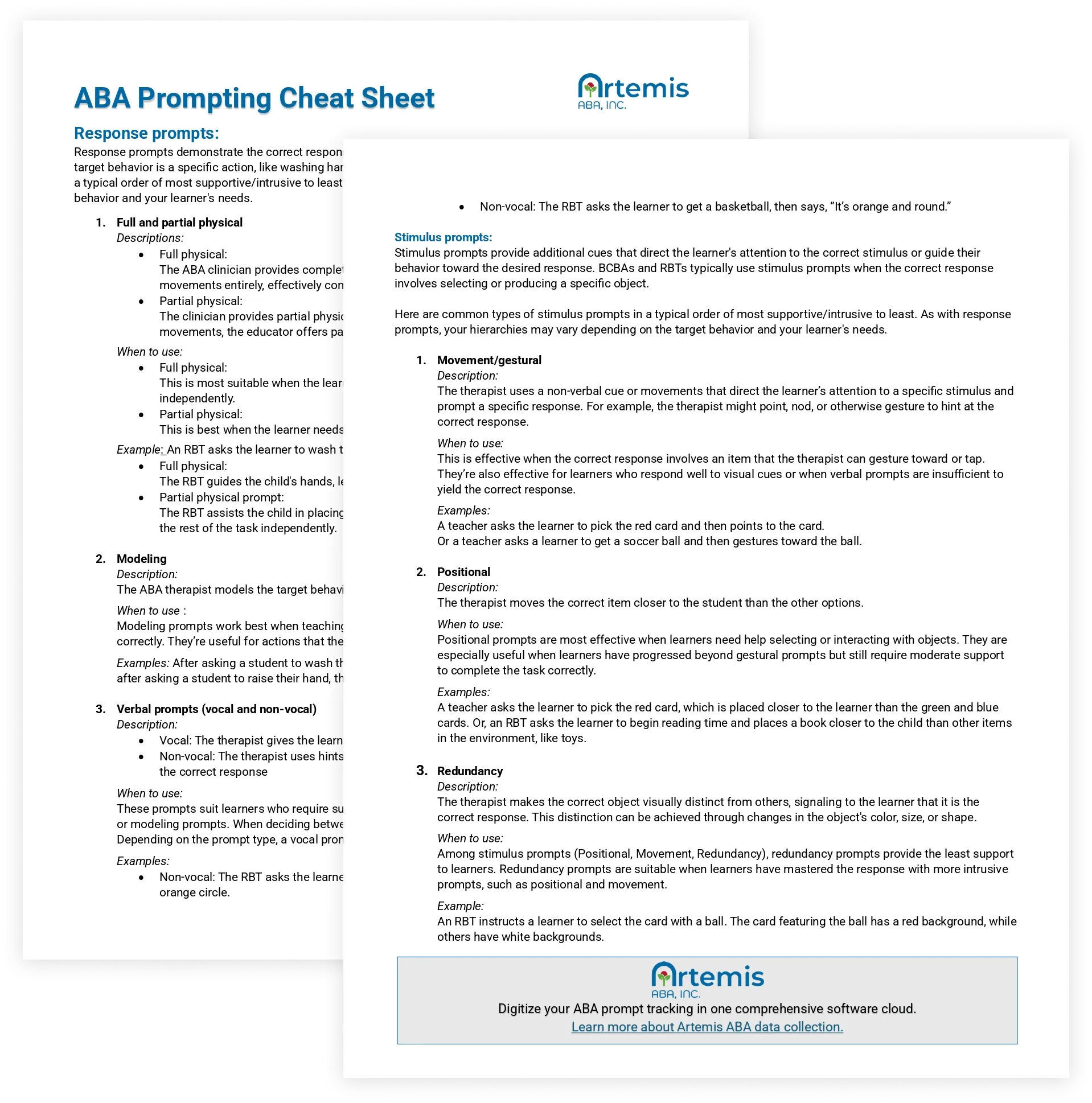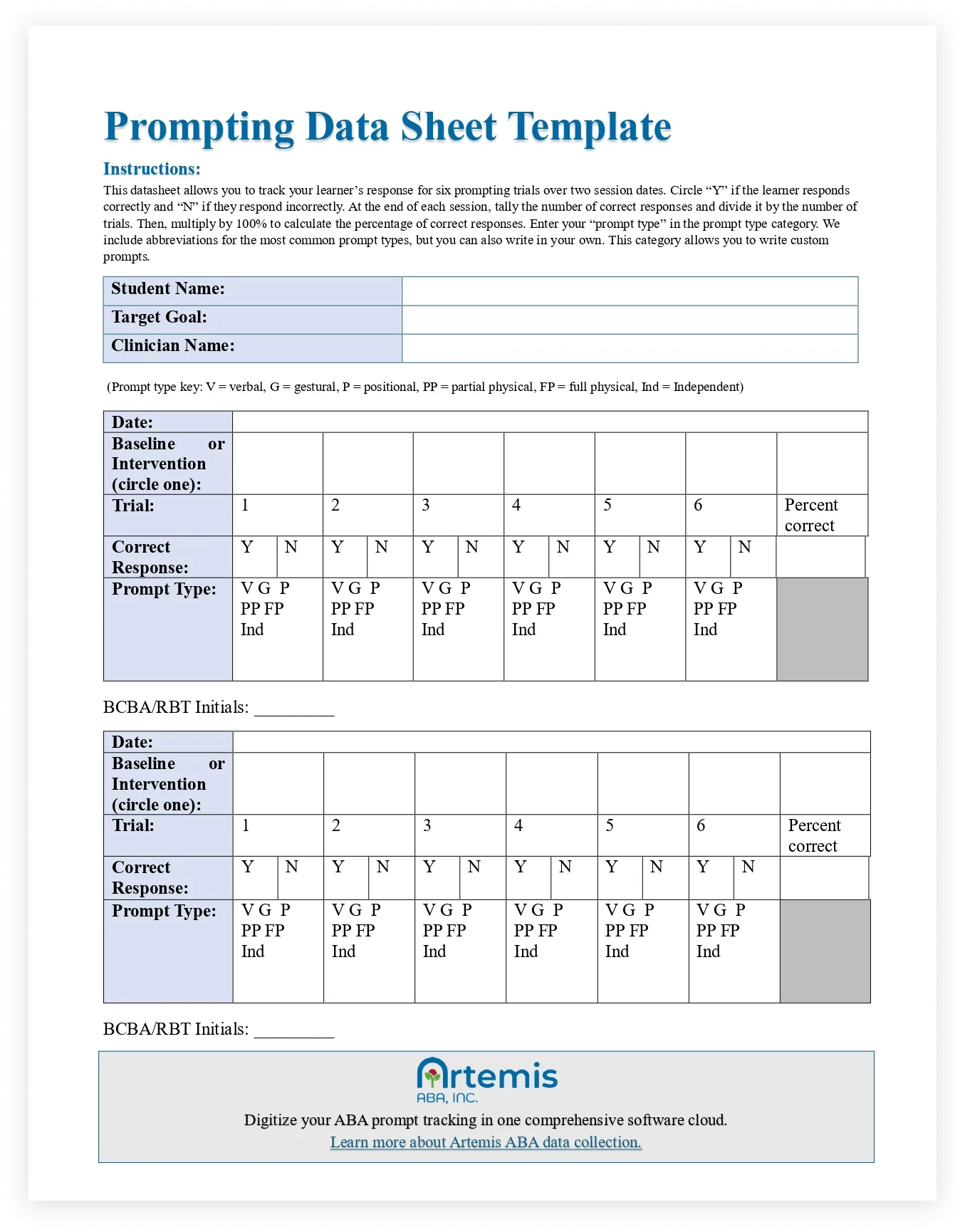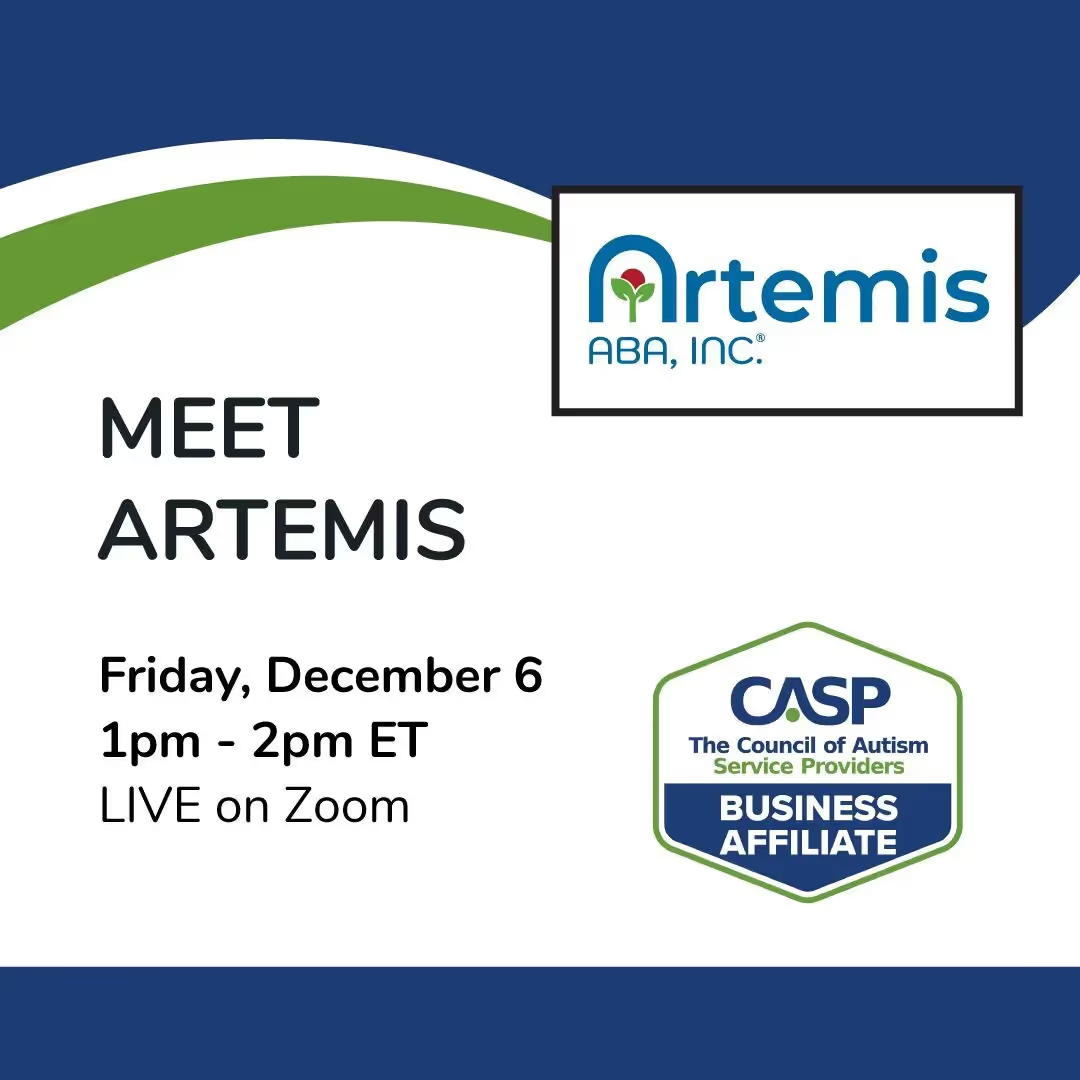Monday to Friday, 7 AM – 7 PM CST.
If you're reaching out outside these hours, please submit a support ticket—our team will respond as soon as possible.

ABA Prompts: Types, Examples and Data Templates
Learn how ABA prompts help learners gradually master new skills. Explore the types of prompts and get tips from BCBAs on making data-driven decisions and creating individualized prompting programs.
Inside this article:
- Types of ABA prompts
- How to troubleshoot ABA prompts
- ABA datasheet templates for prompt tracking
- Electronically tracking ABA prompts
What are ABA Prompts?
ABA prompts are cues or hints that help learners respond correctly to a question or instruction. They can include gestures, verbal cues, physical hints, and more. These prompts help ABA professionals gradually teach patients to engage in the target behavior independently.
For example, ABA prompts can involve modeling the behavior, physically guiding the learner's movements, or providing verbal instructions.
Here's a quick overview of how prompting works: A clinician asks the child a specific question or gives them an instruction. ABA professionals call this statement or question the “discriminative stimulus" or “SD” for short. In ABA, the discriminative stimulus is a signal that tells the learner a specific behavior will lead to a consequence or reward. For example, in a classroom setting, the discriminative stimulus, “Raise your hand if you know the answer,” prompts the child to raise their hand for the opportunity to answer the question.
In this situation, an ABA “prompt” is a cue that the teacher or clinician adds after the SD but before the learner responds. The goal is to guide the learner to the correct response and reduce the likelihood of an error. For example, in the example of raising a hand, the teacher might state, “Raise your hand if you know the answer,” and then model the behavior by raising their own hand.
Ally Dube, M.S., LABA, BCBA, says prompting is a scientifically backed process to teach new skills and replacement behaviors. Dube has more than 20 years of experience in ABA as a practitioner, business owner, parent, and advocate.
“You can think of a prompt like a hint,” she says. “We are using some type of subtle or obvious prompt to help the learner respond correctly.”
Prompting supports some of the fundamental principles in ABA.
Common types of ABA prompts include physical prompts, where the therapist physically assists the learner, and verbal prompts, where the educator provides verbal cues or instructions. The goal is to gradually “fade out” the prompts until the learner independently engages in the behavior.
Ultimately, the objective of many prompting programs is for learners to become self-sufficient in various key skills. As Dube emphasizes, the goal is for therapists to "work themselves out of a job."
That highlights one of ABA’s core goals: Helping learners become independent and self-sufficient across various skills and contexts.
Key Takeaways:
- ABA professionals use a prompt immediately after they present a stimulus to help the learner respond correctly.
- The two main groups of prompts are stimulus prompts and response prompts. They offer different degrees and types of support.
- Prompting supports error-free learning, which helps a learner gradually learn a skill while reducing frustrating errors.
- Customize the prompt type, prompting schedule, and any reinforcement to align with the learner’s skill set and preferences.
- Collecting data on the prompt type and learner’s response is critical to making data-informed treatment changes.
- Electronic data collection and practice management software automates tedious data collection tasks, allowing ABA professionals to focus on delivering high-quality care.
How are ABA Prompts Used?
ABA professionals use a prompt immediately after asking the learner to perform a behavior. The prompts increase the likelihood that the learner will respond correctly. Over time, the therapist will phase out prompting as the learner improves and eventually masters the skill.
Here are specific practices that BCBAs and RBTs use for ABA prompts:
When are ABA Prompts Used?
ABA therapists use prompts to teach a child a specific behavior or skill. Generally, therapists teach replacement behaviors for maladaptive ones or help a learner master a life skill.
Dube gives this example for replacement behaviors: “Let’s say you have a child who throws themselves down on the floor and kicks and screams whenever they want an iPad. Maybe in the past, this behavior has helped them access the iPad under those conditions. In ABA, we would identify a replacement behavior and use prompting techniques to teach the replacement behavior to them. For example, we might point at the iPad and provide the instructional cue of ‘say iPad’ to teach them to request it verbally.”
Dube says prompting also helps teach basic life skills. “Many of our learners have significant communication deficits,” she says. “Part of our job is making sure that we teach the fundamental skills that they’re missing. Prompting is one of the most effective strategies we have when it comes to this type of basic skill acquisition.”
Types of ABA Prompts
The two main categories of ABA prompts are response and stimulus prompts. In the response category, prompt types include physical, verbal, and modeling. Stimulus prompt types include positional, gestural, and redundancy. Each prompt type offers a different degree of support to the learner.
“Stimulus prompts help prompt the response by making the ‘stimulus’ stand out,” Dube explains. “In ABA, the stimulus usually refers to some sort of object in the environment that is related to the correct answer, like a card or the actual object itself.”
She gives this example:
“If we have three cards and we ask the learner to point to the card with a ball, that card is the stimulus, and the correct response is the act of pointing to the ball. So, if we had a stimulus prompt, we might make the correct card stand out in some way. We could make it a different color, make it bigger than the other cards, or make it a different shape."
Response prompts, on the other hand, show the learner what the correct response should look like.
“These prompts operate directly on the response and don’t require the ABA practitioner to manipulate a physical object,” Dube says. “These prompts don’t require the ABA practitioner to manipulate a physical object. For example, a response prompt might involve using a physical prompt to put the learner’s body in the correct position or using a verbal prompt to elicit the correct response.”
Each specific prompt type offers a different degree of support to the learner. For example, physical prompts, where a clinician physically moves the learner’s body to begin the task, are very intrusive and offer high levels of support. On the other hand, gestural prompts, where someone may point or gesture to a stimulus that relates to the correct response, may offer less support. However, it’s important to note that which prompt offers the “most” support and the “least” can depend on the specific combination of the learner and the skill they’re trying to learn.
Here's a deep dive into each prompt type within the stimulus and response categories
Why Use ABA Prompts?
Clinicians use ABA prompts to teach skills gradually. This approach has several advantages. It’s straightforward to implement and gather data on the results. It supports error-free learning, which lessens the learner’s frustration. It’s useful in Discrete Trial Training (DTT). Ultimately, it supports the learner’s independence.
Here’s a more detailed look at the advantages of ABA prompting:
Strategies for Troubleshooting when an ABA Prompt is Ineffective
When an ABA prompt isn’t working, experts recommend trying three strategies. First, assess whether the prompt type is the best option. Then, try increasing the number of trials. Finally, try changing or adding positive reinforcement to give the learner a clear reward.
When faced with ineffective prompting, Dube says she reviews the prompting data and asks herself these questions:
The Importance of Individualizing ABA Prompts
Individualizing ABA prompts improves their effectiveness by fitting each learner’s needs and abilities. The ABA professional customizes the prompt type, schedule, and more based on the learner. This strategy ensures that each learner receives targeted support.
Prompting programs should start with an individualized assessment of each learner’s current skill level and learning needs.
Before starting any program, a BCBA collects baseline data to identify the learner’s skill level and preferences. This assessment enables data-driven decisions about the type of prompt, the frequency of prompting (how many times the learner is prompted per session), and the gradual reduction of prompts ("fading").
Here's a summary of how BCBAs use data-driven programming to individualize prompts:
Planning for Tracking ABA Prompting
Establish a data collection program before you start a prompting program. Record how the learner responded in each trial. This data helps gauge the learner’s mastery of specific prompts and determines if you need to adjust a prompt type.
Download our free ABA data sheet to record prompts used and learner responses. This free resource will help you track your learner's progress along your prompt hierarchy.
Prompting is an important part of many discrete trial training (DTT) sessions.
Download our free prompting DTT datasheet to monitor specific prompts and responses in your DTT program.
Electronic ABA Data Collection for Prompt Tracking
Digital tools streamline data collection and tracking for prompting programs. They automate tasks, minimize errors, and free up clinicians’ time so they can focus on quality care. These software solutions also support data analysis and data-driven decision-making.
Over the last few decades, ABA has experienced a trend toward digitizing every aspect of the practice – from filing insurance claims to electronic data collection. The technology automates tedious tasks that clinicians and other ABA professionals once performed manually. This gives BCBAs and RBTs far more time and energy to focus on using their skills to offer quality, targeted support to each client.
Dube says that the technical advances have greatly benefited data collection.
“Data collection has become so much easier,” she says. “We used to collect data manually and then import that handwritten data into an Excel spreadsheet. That process is frustrating for clinicians. We didn’t go to school to spend hours importing data. It’s also frustrating for clinic owners, who want to pay these clinicians to use their skillset, not to perform tedious tasks. Electronic data collection removes many of these burdens and frees up the BCBA’s energy to deliver quality care.”
This technology can automatically take the data you gather and generate important statistics, like the percentage of correct responses over time. Top software tools can accommodate discontinuous data along with common continuous measurements. These graphs can help you identify patterns and lead you to adjust the prompting programming, like the prompt type or schedule.
Dube stresses that the data analysis features can help but that BCBAs and RBTs should always rely on clinical experience. “Of course, electronic data collection and analysis is a helpful tool, but it’s critical that BCBAs and RBTs don’t allow software to trump clinical experience when it comes to making programming decisions.”
Dube adds: “Make sure your software allows you to customize specific prompts and have the opportunity to schedule and plan prompt fading. These features are a sign that the company understands the role of clinical experience and integrates this knowledge into customizable features, like custom prompts, that the BCBA can control.”
Experts stress that the best software offers a comprehensive practice management solution that integrates data collection and a suite of other ABA-focused features in a single end-to-end platform.
Comprehensive ABA Prompt Tracking with Artemis ABA
Artemis ABA's comprehensive practice management software supports ABA professionals in delivering high-quality care. Leverage your expertise confidently with our advanced tools for customized prompts, precise prompt tracking, data collection, and informed decision-making.
Artemis ABA understands the importance of data in programs like prompting. That’s why Artemis ABA’s data collection tools empower clinicians to make high-quality, data-driven programming decisions. This is key to ensuring each learner receives the right prompts and eventually masters the skill. BCBAs and RBTs can customize prompt types, plan prompt fading, collect data directly within the software, and instantly graph data over any time frame to inform programming decisions.
Also, Artemis handles the heavy lifting of tedious tasks like storing data, making data entry faster and simpler. With Artemis, you can securely store all your data in one place, ensuring easy access and organization. This efficiency translates into significant time and energy savings for you and your team, allowing you to focus on tailoring programs and delivering high-quality care.
Plus, Artemis offers end-to-end solutions, not just for data collection but for all aspects of ABA practice, ensuring comprehensive support from start to finish.
Schedule Your Walkthrough
Please enter your details and one of our team members will contact you shortly
See Artemis in Action
Enter your information below















%201.webp)


